Learning with Technology
Learning Environment Preferences
Resistance is futile. Students' preferences for courses that assimilate both face-to-face instructional components with technological features of the online environment continue to gain momentum across higher education. For the fourth year in a row, the number of students preferring a blended learning environment has increased (see figure 8). For 2017, the percentage of students preferring courses that incorporate online components for some, half, or most of their courses is 79%, an increase of five percentage points since last year. The percentage of students resisting the blended trend and preferring either fully online courses or fully face-to-face courses continues to decrease (by one percentage point each), albeit slightly. Finally, students residing in the neutral zone—those who express no preference for their learning environment—appear to be rapidly diminishing in number, losing a full one-third of their population since 2016.
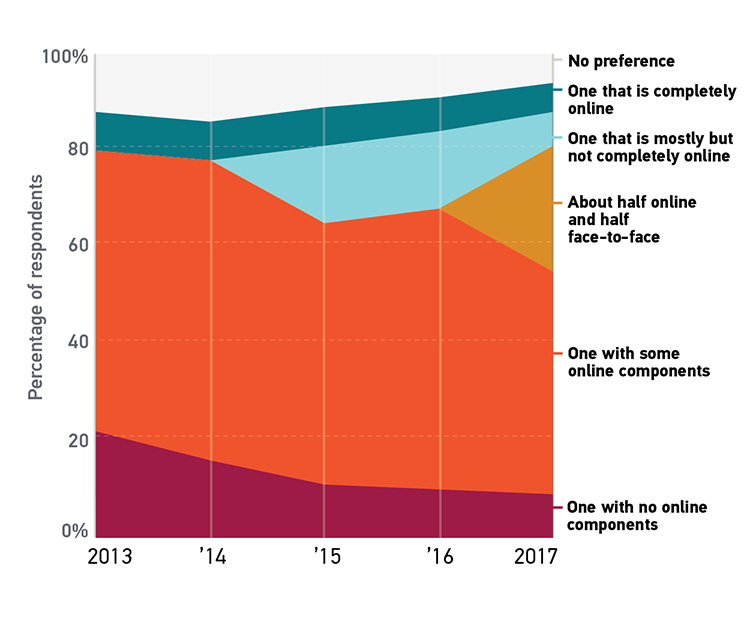
Why do students prefer a particular learning environment over another? Last year we found that one of the key determinants of student learning environment preferences was whether students had taken courses in those respective learning environments in the previous year.1 This year we asked students about the learning environments in which they think they learn best and found that this opinion is highly and significantly associated with learning environment preferences, too. Controlling for having taken courses in particular learning environments, we found that students prefer the modality in which they think they learn best, with the exception of fully face-to-face courses. Students who think they learn best in completely face-to-face courses actually are slightly more likely to prefer one with some online components than they are a completely face-to-face one.2 While this latter point may be an indication of student culture adapting to the service of online course components, student preferences for and beliefs about the efficacy of blended learning may be reflecting what research continues to tell us: Blended learning as a modality of instruction and learning is superior to either fully online or fully face-to-face.3 Indeed, new research supports this, especially when the technology serves as a catalyst for changing both what faculty teach and how they teach.4
The empirical evidence strongly suggests that blended learning conditions (where at least a quarter of course content is delivered online) produce significant gains in student learning. It also suggests that the overwhelming majority of students both prefer blended learning environments and believe they learn best in them. This is the evidence faculty say they require to embrace educational technologies.5 Barring the introduction of Borg nanoprobes, how might instructors then take this evidence and put it into action? Generally, abandoning a lecture-based, instructor-centered pedagogy for a student-centered, active learning one might be a good start. Working closely with instructional designers and technologists can facilitate this transition and help identify opportunities for the incorporation of technology into teaching. To the degree that digital technologies can increase flexibility in classroom activities, can give students room to explore, and can engage them in active problem solving, instructors should embrace those technologies. This should be especially true when blended techniques and technologies can be combined with active learning classroom spaces and flipped classroom models for the face-to-face components.6 The structural and technological conditions that make such approaches possible are here and not going anywhere anytime soon; the shifts in pedagogical approach may lag, but they will come. Resistance is futile.
LMS Satisfaction
The learning management system (LMS) is higher education's Swiss Army knife. It is a multitool available to (nearly) every student. It is designed to be versatile, practical, and easy to use and comes with any number of useful features, many of which are rarely or never used (at least well) because users don't know what they are or should be used for (e.g., marlinspike), never really have the opportunity to use it (e.g., hoof cleaner), and/or have other, better options available (e.g., toothpick). When we compare student satisfaction levels with various features of the LMS, a clear division between the basic tools of an LMS and its more sophisticated features becomes apparent (see figure 9). A majority of students are either satisfied or very satisfied with the basic functions that they are able to perform within their LMS—submitting assignments (77%), accessing course content (75%), checking course progress (66%), managing assignments (62%), and receiving feedback on assignments (59%). The more complicated the task or assignment and the higher the level of engagement required, the lower the level of student satisfaction with the LMS—engaging instructors (54%), accessing institutional information (54%), engaging with other students (49%), collaborating on projects (43%), and participating in study groups (40%). It's not that students actively dislike these latter LMS functions (none of them have more than 20% dissatisfaction rates) so much as they are "meh" about them. Indeed, a plurality of students ticked the neutral option for the bottom three activities, suggesting that no more and no less would suit them just fine.
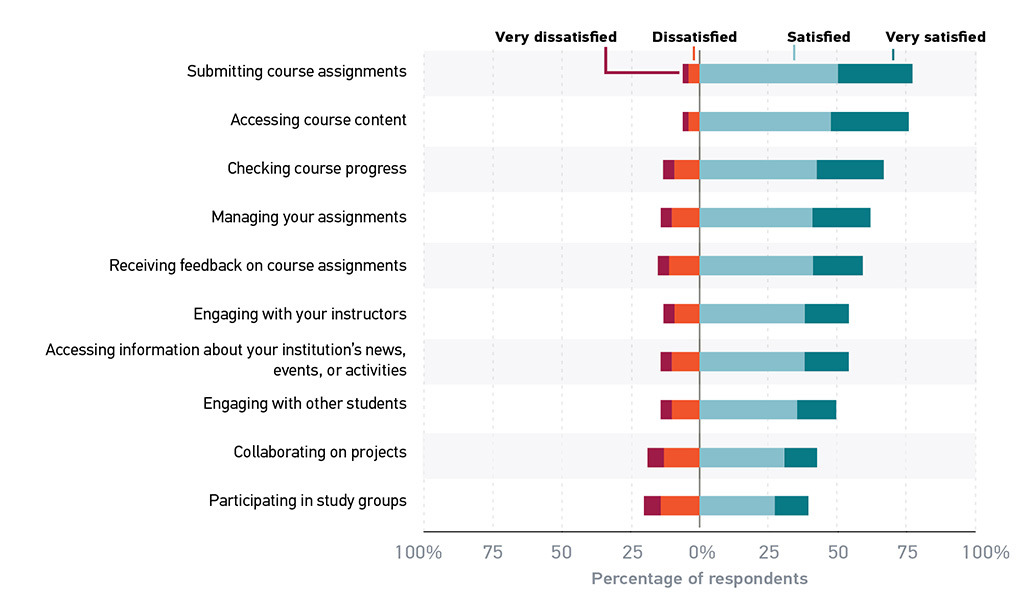
Although it might be tempting to blame the lower satisfaction levels of the more advanced functionality of the LMS solely on the users, the ways in which the LMS is used as a learning tool are probably responsible for these lower satisfaction rates. Certainly, instructors could do more to better scaffold assignments to engage students, and students could do more to actually engage in the activities designed for them.7 Where the LMS falls short as a learning tool is that it is a one-size-fits-all system focused on managing processes associated with learning. Higher education needs to move away from a management system to a learning environment that encompasses a host of interactive components that are student centered and "enable learning of all kinds to flourish."8 Next-generation digital learning environments (NGDLEs) that address issues of interoperability; personalization; collaboration; accessibility and universal design; and analytics, advising, and learning assessment9 are a relatively new concept that is beginning to get some attention and traction in higher education IT circles.10
For NGDLEs to be taken seriously as customizable learning tools that meet the individual needs of instructors and students, technical and cultural obstacles need to be overcome. Addressing the technical aspects of developing open standards for interoperability and methodologically sound applications that harness learning analytics,11 while difficult, may be the easier of these tasks. Changing teaching culture so that instructors use more features of the learning environment than just the basic tools (with which they tend to be fairly satisfied) and use them better might be a bit more difficult. IT investment in faculty use of the current LMS to promote best practices and pedagogical scaffolding for online assignments does three things: 1) provides instructors with the ability to design the new tool with features that are the most wanted and needed, 2) allows them to have input on the exclusion of bells, whistles, and hoof cleaners that never get used or used properly, and 3) lays the foundation for future adoption and use of NGDLEs. On the other hand, IT leaders and their organizations need to see NGDLE as more than just another IT project and to cultivate the alliances and partnerships across the university that will engender buy-in and cooperation to render new tools that are practical, customizable, and effective improvements to teaching practices and learning outcomes.
Technology (What Students Want)
The best things in life are free, but students want technology. That's what they want. And they want their instructors to use more (most) of it in their courses. And rational self-interest is the primary determinant of which technologies they prefer. Once again, we asked students what resources/tools they wish their instructors used less and more, and they told us that regardless of the resource/tool, on average, they want more of it. When we look more closely at the data, however, we see that not all technologies are equal in the eyes of today's undergraduate students. With the exceptions of students' tablet use, e-portfolios, and social media, greater proportions of students wanted more use of particular tools and resources than less use (see figure 10). Students' most desired technologies are lecture capture technologies, OER content, early-alert systems, and the LMS, all of which have quadruple the number of students who want more use of these technologies than less.
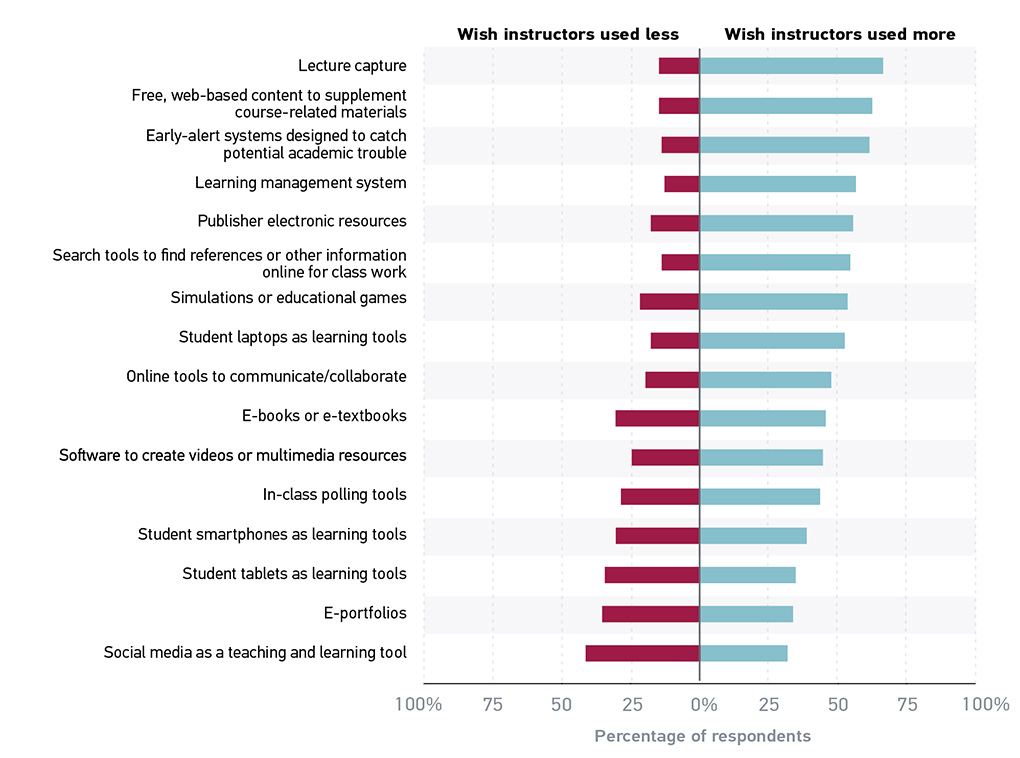
On the surface, the reasons behind these preferences are not entirely clear. A deeper analysis of the data, however, reveals that there are two families of technologies drawn along fairly unusual lines of taking and giving. The first group—students' laptops, tablets, and smartphones; simulations/games; polling; e-portfolios; and social media—seems to "take" from students in that these technologies require students to either use their private devices and accounts or produce content for the consumption of others. Unless faculty clearly and openly state the pedagogical benefits of using these technologies to enhance content, context, and learning expectations, students may be less enthusiastic to engage in these kinds of activities.12 The second group—including lecture capture, OER materials, early-alert systems, search tools, publisher resources, online collaborative tools, video/multimedia software, and electronic texts—seems to focus on technologies that "give" something (e.g., content, information, help, guidance) to the student. Students would like to see greater use of technology that helps them do the work of being students—that is, getting information and getting stuff done. In the simplest terms, students generally prefer technologies that provide immediate and clear benefits.
How should technology professionals, teaching and learning professionals, and instructors proceed with this information? In specific, we recommended faculty avoid even the appearances of the "creepy treehouse" by refraining from building assignments that require students to use their personal social media accounts.13 As should be the case with any technology, the use of social media should be accompanied by a clear pedagogical goal and should give students the option of using a dummy account for the purposes of the course. The utility of e-portfolios of student work beyond the individual course or major program needs to be assessed and evaluated by those who assign them;14 likewise, simulations and games that are not tied clearly to learning outcomes should be avoided. We can't get behind abandoning the use of student devices for classroom activities and exercises—the practical and financial benefits of BYOE are real and need to be embraced more by both faculty and students. Furthermore, avoiding the use of polling technologies simply because some students want less of them (especially if we don't know why they don't like them) is an untenable position, particularly when there are so many good examples of how clickers and other devices can be employed effectively.15 Finally, embrace, support, and use deliberately the technologies that students desire more use of and avoid the temptation to adopt a posture of in loco parentis, deciding what is best for students. They often know what technology can get them. And, while technology don't get everything, it's true, what it don't get, students can't use. Just give them technology.
Uses, Abuses, and Consequences of Classroom Device Use
Breaking news! Students report the most hostile postures from faculty toward student devices in the classroom in years! Faculty are banning or discouraging the use of all types of devices in the classroom more than in recent years! And some devices are the object of instructor ire more than others! Stay tuned to find out how far out of favor your favorite classroom device has fallen from the ivory tower! Now, here's Tom with the weather.
Actually, there is not much "breaking" about this finding. Smartphones continue to be the most despised technologies among instructors, with 70% of students saying their instructors ban (23%) or discourage their use (47%) in class (see figure 11). What does qualify as news, however, is that these numbers represent the reversal of a downward trend over recent years in the restrictions faculty place on smartphones.16 Similarly, the percentage of students who said their instructors are restricting the use of tablets in the classroom also has risen, from about 25% in 2015 to 40% in 2017. The only contrary outcome appears to be that the percentage of students who say their instructors encourage or require laptop use in class is up, from 30% in 2015 to 35% in 2017.
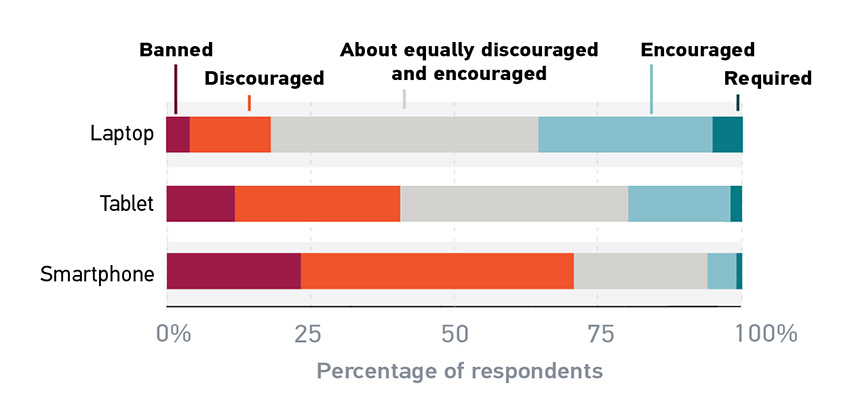
What turn of events can help us understand why fewer faculty—at least according to students—appear willing to harness the power of mobile devices in the classroom? At least three plausible reasons emerge. First, there is evidence that device usage in the classroom may undermine student performance in their coursework.17 While there are some solid pieces of research supporting restricted device use to improve student performance,18 the evidence is neither conclusive nor ubiquitous and therefore doesn't warrant full-fledged bans; confirmation bias may be playing a role in faculty decisions to ban or discourage devices. Second, instructors might believe that students are using their devices for nonclass activities significantly more than students say they do this, and faculty might perceive substantive differences in how different devices are used for different classroom tasks (e.g., taking notes, looking up information, participating in assigned activities).19 While it's true that some students who have devices at their disposal reported using them for nonclass activities (smartphones, 45%; laptops, 28%; tablets, 11%) and that students readily admit to being distracted by digital technologies,20 they also use all of the devices for a number of class-related activities (see figure 12). And, even though no one really multitasks well (although we can switch tasks at breakneck speeds), stripping students of the technologies that are critical to their work as students is shortsighted at best—we don't, for example, take away notebooks and pens from students because they doodle. Moreover, students with documented disabilities that allow them to use assistive technologies in the classroom might feel singled out, ostracized, or resented by others who perceive unfair or preferential treatment. Finally, the instructors who seek to ban devices in the classroom may be mired in an instructor-centered pedagogy that reflects the desire to control what goes on in the classroom21 or feel the need to have students' attention fully focused on them and their slides or boardwork. Active learning strategies that put the student at the center of the classroom experience and direct students' focus of attention are more likely to be led by instructors who see the value of students' using their devices to enhance or improve their learning experiences.
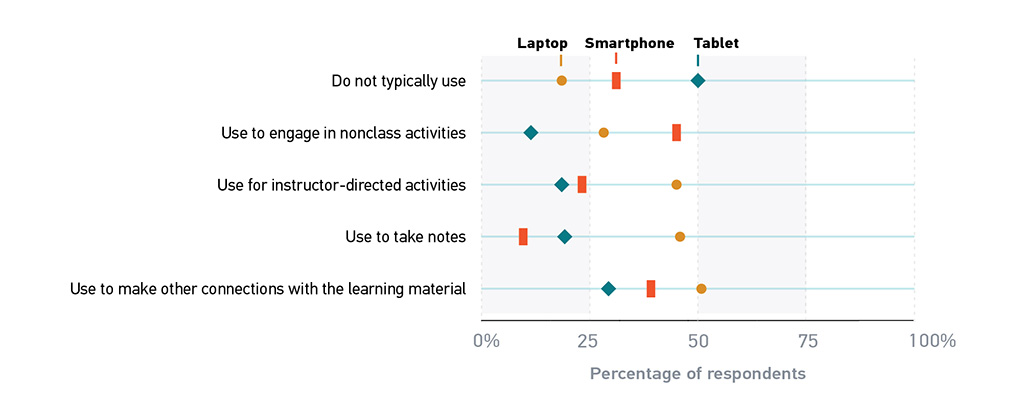
The brinksmanship between students and faculty over the use of digital technologies in the classroom appears to be getting more intense. Faculty are increasingly banning and discouraging students from using their laptops and smartphones at the same time that those devices are becoming even more important to students' academic success. What is to be done?
- Students: You need to keep your eyes on the prize. If your devices are as critical to your academic success as you say, when in class use them only for classroom tasks—notetaking, looking up information, engaging in assigned activities, participating in collaborative tasks. Every time your instructor observes you doing something you shouldn't be doing on your device while in class, you are giving your instructor the ammunition to justify banning them altogether. If you know you have problems resisting Pavlovian urges every time you receive an alert, close your applications, turn your devices off, or put them in airplane/sleep mode. You aren't nearly as good at multitasking as you think you are.22 Show your instructors that you mean business.
- Faculty: Start treating your students with the respect afforded to adults in similar situations by letting them make their own choices and mistakes in the use of digital devices. Treating undergraduate students as children will only engender disdain and contempt for your efforts to help them achieve desired learning outcomes. Instead, develop reasonable policies that respect the practical, diverse, and responsible ways that students use their devices in class. Perhaps work with students to craft policies tailored to the needs of each particular course. Moreover, leverage those opportunities to the benefit of your teaching and the learning of the students in the classroom. Finally, consider whether the use of devices for nonclass activities is a function of disrespect or a lack of engagement. If the former, then certainly such activities should not be tolerated and should be dealt with discretely; if the latter, however, consider the ways in which your pedagogical approach might be limiting students' opportunities to engage with the material, you, and other students and do something to change that. Another option is to have a discussion with students about the use of devices in class and work together on a policy that best meets the needs of both parties. Student technology in the classroom is not going to go away; coming to a resolution on it would certainly be welcome news.
Notes
-
D. Christopher Brooks, ECAR Study of Undergraduate Students and Information Technology, 2016, research report (Louisville, CO: ECAR, October 2016)
↩︎ -
A student who thinks she learns best in a course with no online components has a 48% probability of preferring a course with no online components compared to a 50% probability of preferring a course with some online components.
↩︎ -
See Barbara Means, Yukie Toyama, Robert Murphy, Marianne Bakia, and Karla Jones, Evaluation of Evidence-Based Practices in Online Learning: A Meta-Analysis and Review of Online Learning Studies (Washington, D.C.: U.S. Department of Education, Office of Planning, Evaluation, and Policy Development, 2010); and Barbara Means, Yukie Toyama, Robert Murphy, and Marianne Bakia, "The Effectiveness of Online and Blended Learning: A Meta-Analysis of the Empirical Literature," Teachers College Record 115 (New York: Teachers College, Columbia University, 2013).
↩︎ -
Doug Lederman, "What Works in Blended Learning," InsideHigherEd, July 26, 2017.
↩︎ -
D. Christopher Brooks, with a foreword by John O'Brien, ECAR Study of Faculty and Information Technology, 2015, research report (Louisville, CO: ECAR, October 2015): 14–15, and Jeffrey Pomerantz and D. Christopher Brooks, ECAR Study of Faculty and Information Technology, 2017, research report (Louisville, CO: ECAR, October 2017).
↩︎ -
Paul Baepler, J. D. Walker, and Michelle Driessen, "It's Not about Seat Time: Blending, Flipping, and Efficiency in Active Learning Classrooms," Computers & Education 78 (2014): 227–236.
↩︎ -
John Whitmer, "Patterns in Course Design: How Instructors ACTUALLY Use the LMS," Blackboard Blog, October 27, 2016.
↩︎ -
Malcolm Brown, "The NGDLE: We Are the Architects," EDUCAUSE Review, July 3, 2017.
↩︎ -
"7 Things You Should Know about NGDLE," ELI, December 2015.
↩︎ -
See the July/August 2017 edition of EDUCAUSE Review for more on this topic.
↩︎ -
Malcolm Brown, "The NGDLE: We Are the Architects," EDUCAUSE Review, July 3, 2017.
↩︎ -
Terry Anderson and Jon Dron, "Three Generations of Distance Education Pedagogy," International Review of Research in Open and Distributed Learning 12, no. 3 (2011).
↩︎ -
Jeffrey R. Young, "When Professors Create Social Networks for Classes, Some Students See a 'Creepy Treehouse'," Chronicle of Higher Education, August 18, 2008.
↩︎ -
For some examples of technological applications (especially social media) for student learning, see EdTech Sandbox.
↩︎ -
Derek Bruff, Teaching with Classroom Response Systems: Creating Active Learning Environments (San Francisco: Jossey-Bass, 2009).
↩︎ -
Eden Dahlstrom, with D. Christopher Brooks, Susan Grajek, and Jamie Reeves, ECAR Study of Undergraduate Students and Information Technology, 2015, research report (Louisville, CO: ECAR, December 2015): 20.
↩︎ -
Richard W. Patterson and Robert M. Patterson, "Computers and Productivity: Evidence from Laptop Use in the College Classroom," Economics of Education Review 57 (April 2017): 66–79.
↩︎ -
Pam A. Mueller and Daniel M. Oppenheimer, "The Pen Is Mightier Than the Keyboard: Advantages of Longhand Over Laptop Note Taking," Psychological Science, May 22, 2014.
↩︎ -
Eden Dahlstrom, with D. Christopher Brooks, Susan Grajek, and Jamie Reeves, ECAR Study of Undergraduate Students and Information Technology, 2015, research report (Louisville, CO: ECAR, December 2015): 18.
↩︎ -
D. Christopher Brooks, ECAR Study of Undergraduate Students and Information Technology, 2016, research report (Louisville, CO: ECAR, October 2016): 30–34.
↩︎ -
Aubree Evans, "Active Learning in the Age of Classroom Cellphones," InsideHigherEd, July 11, 2017.
↩︎ -
Kep Lee Loh and Ryota Kanai, "Higher Media Multi-Tasking Activity Is Associated with Smaller Gray-Matter Density in the Anterior Cingulate Cortex," PLOS One 9, no. 9 (September 2014); and J. M. Watson and D. L. Strayer, "Supertaskers: Profiles in Extraordinary Multitasking Ability," Psychonomic Bulletin & Review 17, no. 4 (August 2010): 479–485.
↩︎